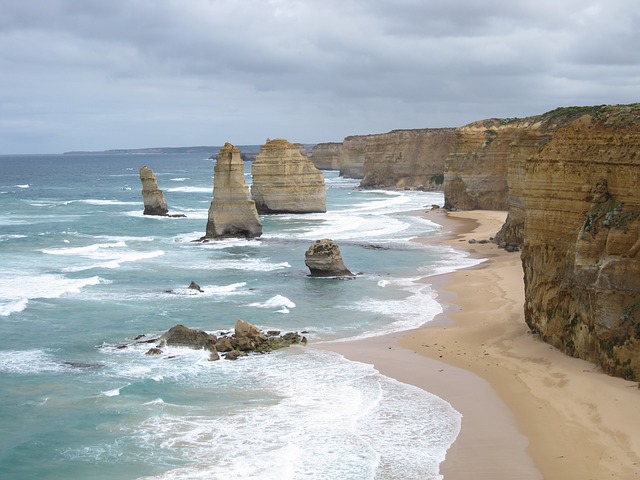Tourism in the Great Ocean Road region captures around 7 million visitors, contributing over 7,000 jobs and a direct economic output of $1.1 billion per year. Forecasts indicate that the popular tourist region will attract up to 10.5 million visitors annually by 2030 – a growth of 3.5 million. To support major growth like this, workforce development strategies will underpin a positive visitor experience.
Contributing $12.5 billion Gross Regional Product
The Great Ocean Road region has the second largest population centre in Victoria. With strong representation from agriculture, manufacturing, retail, tourism and health, the region has a lower value-added contribution per worker than Melbourne, due to a concentration of employment in trade-based and labouring rather than professional/high value-added industry sectors.
The City of Greater Geelong identifies the region’s enormous economic and cultural opportunities, through an Economic Development Strategy that aims to fulfil key objectives including:
- Prioritise new and existing economic development opportunities;
- Identify opportunities that will lead to an increase in wealth, prosperity and regional ?standards of living;
- Identify the genuine competitive advantage of the G21 region;
- Produce a compelling and evidence-based map showing how to ‘build value’ into the G21 regional economy; and
- Provide advice on the most appropriate governance model to implement the strategy.
Two core focuses are on labour force capacity and economic diversity. The strategy outlines individuals to be skilled in new areas and industries, with new skills being attracted to the region to assist in broader capacity development of labour force. This, coupled with strong attention on industry with flow on effects, is integral to the region’s growth.
A workforce driven by strong trade skills
The G21 region has a lower level of education compared to Melbourne with half as many residents holding postgraduate qualifications and 40% more residents reporting year 10 as their highest level of qualification.
However, the G21 region does have strong trade-based skills, with a higher proportion of workers with certificate level skills than Melbourne.
The region has higher unemployment than Melbourne, with areas of significant disadvantage, clustering of unemployment and low education levels in certain sub-regions (e.g. North Geelong, Bellarine). There is also significant clustering of low-skilled residents without access to motor vehicles or public transport, which is a significant issue for workforce participation.
The region’s workforce has a higher proportion of both younger and near-retirement age workers, which would also contribute to the generally lower skill level across the region.
Lorne: Victoria’s fastest growing municipality
The Surf Coast Shire has been recognised as one of Victoria’s fastest growing municipalities for more than a decade. Worth almost $1 billion annually, Surf Coast Shire’s economy is growing at almost four times the rate of other rural Victorian municipalities.
Many of the shire’s 14,000-strong labour force work is in Geelong. Locally, some 3,060 businesses employ more than 7,100 people. Surf companies Rip Curl and Quiksilver are (NB. Quiksilver filed for bankruptcy in the USA) among the top employers, along with Surf Coast Shire Council and Barwon Health. The tourism, construction and retail sectors account for 41 per cent of all employment in the shire.
Construction represents the most common business type (700 businesses) while the rental hire and real estate services sector contributes $150 million annually, which makes it the largest in terms of value-add activity. Over the past 10 years, more than $2.54 billion worth of residential and commercial activity has occurred in Surf Coast Shire, placing it above many of Victoria’s regional cities.
In 2013, more than 1.67 million visitors spent $410 million in Surf Coast Shire, with overnight visitors accounting for over 2.3 million visitor nights. Local beaches represented the main drawcard with more than one million visitors going to the beach in 2013 (excluding multiple visits).
The council’s 10-year Strategic Resource Plan aims to support local businesses and supporting the township’s business sector. This includes a series of workshops to assist participants in making the most of digital marketing opportunities, helping prospective new businesses with location, job creation and investment opportunities, and regular provision of economic statistics and other relevant information.
Warrnambool: A regional centre for health & education
With a $3 billion output and $1.6 billion GRP, Warrnambool boasts a 19,000+ labour force. The town is an important regional employment hub, accounting for over 20% of the Great South Coast region’s economic output from less than 1% of the land area.
The six major industry sectors include healthcare and social assistance, retail, manufacturing, education and training, construction, and accommodation. It is home to and a support centre for industries, which include dairy and meat processing, and wool production. Agricultural production in the Great South Coast region over 2010-2011 was $2.1 billion. This is 18% of Victoria’s total agricultural production of $11.6 billion, generated from just 12 per cent of Victoria’s land mass.
The value of construction in Warrnambool annually exceeds $100 million, while the next two decades the region expects to see more than $2 billion invested in the region’s housing and land. Over the past two decades, Warrnambool’s population has increased by 25% – the highest rate of all Victorian regional centres.
Supporting growth through workforce development
Although the Great Ocean Road is a vibrant and diverse economy, there are still cultural barriers to skills development. Employment in the region is concentrated in industries with low value-added production, which is a result of the trade-based skill sets most common across the region.
With a growing population expected to increase at a faster rate than Melbourne, the Great Ocean Road region would benefit from customised workforce development to fully leverage its strengths, fostering collaboration between local businesses all enhancing the visitor experience and lifestyle.
If you would like to know more about workforce development strategies for your region and priorities, please contact Wendy Perry via wendy@wb.switchstartscale.com.au.
September 2015

